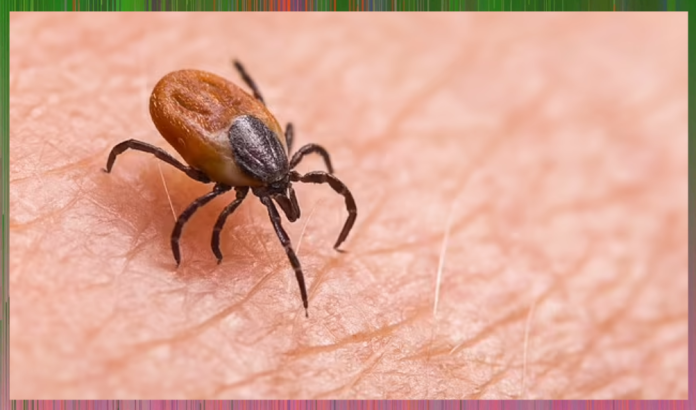In recent years, there has been an increasing presence of giant ticks, particularly the Hyalomma marginatum species, in various parts of Europe. These ticks, also known as tropical or Asian ticks, are larger than the common tick species found in Europe, measuring around 5-6 millimeters in size. While their presence may be alarming, it is crucial to understand the risks they pose and take appropriate actions to protect oneself.

Identifying Giant Ticks
Giant ticks can be distinguished from other tick species by their larger size and distinctive appearance. They have a rounded body shape and a hard, shield-like structure called a scutum on their back. Their color ranges from reddish-brown to dark brown or black. It is important to note that their size can vary depending on their life stage, with nymphs being smaller and adults being larger.
The Diseases Transmitted By Ticks
According to the NHS, the best way to reduce the risk of being bitten is to cover your skin while walking outdoors and tuck your trousers into your socks. Ticks are known to transmit a variety of diseases to humans and animals. These diseases are caused by the bite of an infected tick, which can carry bacteria, viruses, or parasites. Here are some of the most common diseases transmitted by ticks:
- Lyme Disease: Lyme disease is the most common tick-borne disease in the United States. It is caused by the bite of an infected blacklegged tick (Ixodes scapularis) and is characterized by symptoms such as fever, headache, fatigue, and a distinctive rash known as erythema migrans. If left untreated, Lyme disease can lead to more severe symptoms such as arthritis, neurological problems, and heart problems.
- Anaplasmosis: Anaplasmosis is another tick-borne disease caused by the bite of an infected blacklegged tick. It is characterized by symptoms such as fever, headache, fatigue, and muscle pain. Anaplasmosis can lead to more severe symptoms such as respiratory problems and neurological problems if left untreated.
- Babesiosis: Babesiosis is a protozoan infection caused by the bite of an infected blacklegged tick. It is characterized by symptoms such as fever, chills, and anemia. Babesiosis can lead to more severe symptoms such as kidney failure and death if left untreated.
- Ehrlichiosis: Ehrlichiosis is a bacterial infection caused by the bite of an infected lone star tick (Amblyomma americanum). It is characterized by symptoms such as fever, headache, fatigue, and muscle pain. Ehrlichiosis can lead to more severe symptoms such as respiratory problems and neurological problems if left untreated.
- Rocky Mountain Spotted Fever: Rocky Mountain spotted fever is a bacterial infection caused by the bite of an infected American dog tick (Dermacentor variabilis). It is characterized by symptoms such as fever, headache, fatigue, and a rash. Rocky Mountain spotted fever can lead to more severe symptoms such as meningitis and death if left untreated.
- Powassan Virus Disease: Powassan virus disease is a rare but serious tick-borne disease caused by the bite of an infected blacklegged tick. It is characterized by symptoms such as fever, headache, fatigue, and neurological problems. Powassan virus disease can lead to more severe symptoms such as encephalitis and death if left untreated.
- Tularemia: Tularemia is a bacterial infection caused by the bite of an infected American dog tick. It is characterized by symptoms such as fever, chills, and swollen lymph nodes. Tularemia can lead to more severe symptoms such as pneumonia and death if left untreated.
- Bourbon Virus: Bourbon virus is a viral infection caused by the bite of an infected lone star tick. It is characterized by symptoms such as fever, headache, fatigue, and muscle pain. Bourbon virus can lead to more severe symptoms such as respiratory problems and neurological problems if left untreated.
- Colorado Tick Fever: Colorado tick fever is a viral infection caused by the bite of an infected wood tick (Dermacentor andersoni). It is characterized by symptoms such as fever, headache, fatigue, and muscle pain. Colorado tick fever can lead to more severe symptoms such as meningitis and death if left untreated.
- Hard Tick Relapsing Fever: Hard tick relapsing fever is a bacterial infection caused by the bite of an infected wood tick. It is characterized by symptoms such as fever, headache, fatigue, and muscle pain. Hard tick relapsing fever can lead to more severe symptoms such as respiratory problems and neurological problems if left untreated.
- Heartland Virus: Heartland virus is a viral infection caused by the bite of an infected lone star tick. It is characterized by symptoms such as fever, headache, fatigue, and muscle pain. Heartland virus can lead to more severe symptoms such as respiratory problems and neurological problems if left untreated.
- Southern Tick-Associated Rash Illness (STARI): STARI is a tick-borne disease caused by the bite of an infected lone star tick. It is characterized by symptoms such as fever, headache, fatigue, and a rash. STARI can lead to more severe symptoms such as respiratory problems and neurological problems if left untreated.
- Tick Paralysis: Tick paralysis is a condition caused by the bite of an infected tick. It is characterized by symptoms such as muscle weakness, numbness, and paralysis. Tick paralysis can lead to more severe symptoms such as respiratory failure and death if left untreated.
Preventive Measures

To minimize the risk of encountering and being bitten by giant ticks, it is crucial to take the following precautions when spending time outdoors, especially in areas with dense vegetation, tall grass, or wooded regions:
- Wear long-sleeved shirts, long pants, and closed-toe shoes to cover exposed skin.
- Tuck pants into socks or boots to prevent ticks from crawling up your legs.
- Use insect repellents containing DEET or permethrin on exposed skin and clothing, respectively.
- Stick to marked trails and avoid brushing against vegetation.
- Perform thorough tick checks on yourself, your children, and your pets after being outdoors.
What to Do If You Find a Tick
If you find a tick attached to your skin, it is essential to remove it promptly and properly to reduce the risk of disease transmission. Follow these steps:
- Use a pair of fine-tipped tweezers to grasp the tick as close to the skin as possible.
- Pull the tick straight up with steady, even pressure. Avoid twisting or jerking, as this may cause the mouthparts to break off and remain in the skin.
- Clean the bite area with soap and water or an antiseptic.
- Save the tick in a sealed container or plastic bag for identification and potential testing if needed.
- Monitor the bite site for any signs of redness, swelling, or a bullseye-shaped rash, which may indicate Lyme disease or other tick-borne illnesses.
- Consult with a healthcare professional if you develop any concerning symptoms or have concerns about the tick bite.
Reporting Giant Tick Sightings
If you suspect you have encountered a giant tick, it is crucial to report your findings to the appropriate authorities. In Austria, for example, the Agency for Health and Food Safety (AGES) has a dedicated email address ([email protected]) where you can send photos of suspected giant ticks for identification.
This information helps researchers track the distribution and prevalence of these ticks, which is essential for developing effective prevention and control strategies.
The presence of giant ticks in Europe highlights the need for increased awareness and vigilance when spending time outdoors. By understanding the risks, taking preventive measures, and promptly reporting any sightings, individuals can help protect themselves and contribute to the ongoing efforts to monitor and manage the spread of these ticks and the diseases they may carry.
See Also: Olivia Munn’s Reveals Full Hysterectomy Amid Breast Cancer Battle Is The Best Decision For Her



